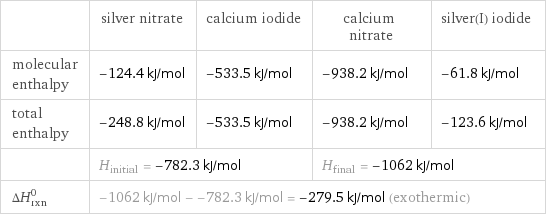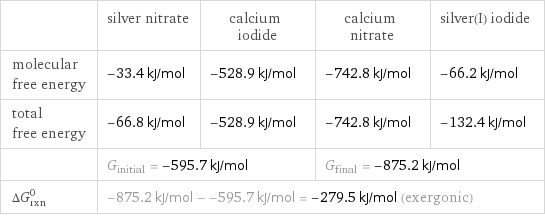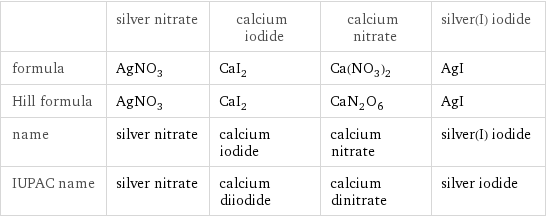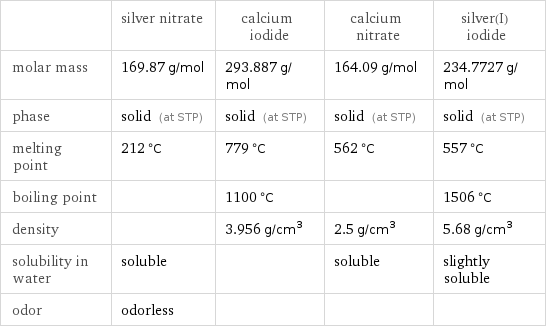Input interpretation

AgNO_3 silver nitrate + CaI_2 calcium iodide ⟶ Ca(NO_3)_2 calcium nitrate + AgI silver(I) iodide
Balanced equation

Balance the chemical equation algebraically: AgNO_3 + CaI_2 ⟶ Ca(NO_3)_2 + AgI Add stoichiometric coefficients, c_i, to the reactants and products: c_1 AgNO_3 + c_2 CaI_2 ⟶ c_3 Ca(NO_3)_2 + c_4 AgI Set the number of atoms in the reactants equal to the number of atoms in the products for Ag, N, O, Ca and I: Ag: | c_1 = c_4 N: | c_1 = 2 c_3 O: | 3 c_1 = 6 c_3 Ca: | c_2 = c_3 I: | 2 c_2 = c_4 Since the coefficients are relative quantities and underdetermined, choose a coefficient to set arbitrarily. To keep the coefficients small, the arbitrary value is ordinarily one. For instance, set c_2 = 1 and solve the system of equations for the remaining coefficients: c_1 = 2 c_2 = 1 c_3 = 1 c_4 = 2 Substitute the coefficients into the chemical reaction to obtain the balanced equation: Answer: | | 2 AgNO_3 + CaI_2 ⟶ Ca(NO_3)_2 + 2 AgI
Structures

+ ⟶ +
Names

silver nitrate + calcium iodide ⟶ calcium nitrate + silver(I) iodide
Reaction thermodynamics
Enthalpy

| silver nitrate | calcium iodide | calcium nitrate | silver(I) iodide molecular enthalpy | -124.4 kJ/mol | -533.5 kJ/mol | -938.2 kJ/mol | -61.8 kJ/mol total enthalpy | -248.8 kJ/mol | -533.5 kJ/mol | -938.2 kJ/mol | -123.6 kJ/mol | H_initial = -782.3 kJ/mol | | H_final = -1062 kJ/mol | ΔH_rxn^0 | -1062 kJ/mol - -782.3 kJ/mol = -279.5 kJ/mol (exothermic) | | |
Gibbs free energy

| silver nitrate | calcium iodide | calcium nitrate | silver(I) iodide molecular free energy | -33.4 kJ/mol | -528.9 kJ/mol | -742.8 kJ/mol | -66.2 kJ/mol total free energy | -66.8 kJ/mol | -528.9 kJ/mol | -742.8 kJ/mol | -132.4 kJ/mol | G_initial = -595.7 kJ/mol | | G_final = -875.2 kJ/mol | ΔG_rxn^0 | -875.2 kJ/mol - -595.7 kJ/mol = -279.5 kJ/mol (exergonic) | | |
Equilibrium constant
![Construct the equilibrium constant, K, expression for: AgNO_3 + CaI_2 ⟶ Ca(NO_3)_2 + AgI Plan: • Balance the chemical equation. • Determine the stoichiometric numbers. • Assemble the activity expression for each chemical species. • Use the activity expressions to build the equilibrium constant expression. Write the balanced chemical equation: 2 AgNO_3 + CaI_2 ⟶ Ca(NO_3)_2 + 2 AgI Assign stoichiometric numbers, ν_i, using the stoichiometric coefficients, c_i, from the balanced chemical equation in the following manner: ν_i = -c_i for reactants and ν_i = c_i for products: chemical species | c_i | ν_i AgNO_3 | 2 | -2 CaI_2 | 1 | -1 Ca(NO_3)_2 | 1 | 1 AgI | 2 | 2 Assemble the activity expressions accounting for the state of matter and ν_i: chemical species | c_i | ν_i | activity expression AgNO_3 | 2 | -2 | ([AgNO3])^(-2) CaI_2 | 1 | -1 | ([CaI2])^(-1) Ca(NO_3)_2 | 1 | 1 | [Ca(NO3)2] AgI | 2 | 2 | ([AgI])^2 The equilibrium constant symbol in the concentration basis is: K_c Mulitply the activity expressions to arrive at the K_c expression: Answer: | | K_c = ([AgNO3])^(-2) ([CaI2])^(-1) [Ca(NO3)2] ([AgI])^2 = ([Ca(NO3)2] ([AgI])^2)/(([AgNO3])^2 [CaI2])](../image_source/07647fcc80a5c33f0a228e7c07fd4a9f.png)
Construct the equilibrium constant, K, expression for: AgNO_3 + CaI_2 ⟶ Ca(NO_3)_2 + AgI Plan: • Balance the chemical equation. • Determine the stoichiometric numbers. • Assemble the activity expression for each chemical species. • Use the activity expressions to build the equilibrium constant expression. Write the balanced chemical equation: 2 AgNO_3 + CaI_2 ⟶ Ca(NO_3)_2 + 2 AgI Assign stoichiometric numbers, ν_i, using the stoichiometric coefficients, c_i, from the balanced chemical equation in the following manner: ν_i = -c_i for reactants and ν_i = c_i for products: chemical species | c_i | ν_i AgNO_3 | 2 | -2 CaI_2 | 1 | -1 Ca(NO_3)_2 | 1 | 1 AgI | 2 | 2 Assemble the activity expressions accounting for the state of matter and ν_i: chemical species | c_i | ν_i | activity expression AgNO_3 | 2 | -2 | ([AgNO3])^(-2) CaI_2 | 1 | -1 | ([CaI2])^(-1) Ca(NO_3)_2 | 1 | 1 | [Ca(NO3)2] AgI | 2 | 2 | ([AgI])^2 The equilibrium constant symbol in the concentration basis is: K_c Mulitply the activity expressions to arrive at the K_c expression: Answer: | | K_c = ([AgNO3])^(-2) ([CaI2])^(-1) [Ca(NO3)2] ([AgI])^2 = ([Ca(NO3)2] ([AgI])^2)/(([AgNO3])^2 [CaI2])
Rate of reaction
![Construct the rate of reaction expression for: AgNO_3 + CaI_2 ⟶ Ca(NO_3)_2 + AgI Plan: • Balance the chemical equation. • Determine the stoichiometric numbers. • Assemble the rate term for each chemical species. • Write the rate of reaction expression. Write the balanced chemical equation: 2 AgNO_3 + CaI_2 ⟶ Ca(NO_3)_2 + 2 AgI Assign stoichiometric numbers, ν_i, using the stoichiometric coefficients, c_i, from the balanced chemical equation in the following manner: ν_i = -c_i for reactants and ν_i = c_i for products: chemical species | c_i | ν_i AgNO_3 | 2 | -2 CaI_2 | 1 | -1 Ca(NO_3)_2 | 1 | 1 AgI | 2 | 2 The rate term for each chemical species, B_i, is 1/ν_i(Δ[B_i])/(Δt) where [B_i] is the amount concentration and t is time: chemical species | c_i | ν_i | rate term AgNO_3 | 2 | -2 | -1/2 (Δ[AgNO3])/(Δt) CaI_2 | 1 | -1 | -(Δ[CaI2])/(Δt) Ca(NO_3)_2 | 1 | 1 | (Δ[Ca(NO3)2])/(Δt) AgI | 2 | 2 | 1/2 (Δ[AgI])/(Δt) (for infinitesimal rate of change, replace Δ with d) Set the rate terms equal to each other to arrive at the rate expression: Answer: | | rate = -1/2 (Δ[AgNO3])/(Δt) = -(Δ[CaI2])/(Δt) = (Δ[Ca(NO3)2])/(Δt) = 1/2 (Δ[AgI])/(Δt) (assuming constant volume and no accumulation of intermediates or side products)](../image_source/9a1af6e9dc40e795f3e62410a185fdd7.png)
Construct the rate of reaction expression for: AgNO_3 + CaI_2 ⟶ Ca(NO_3)_2 + AgI Plan: • Balance the chemical equation. • Determine the stoichiometric numbers. • Assemble the rate term for each chemical species. • Write the rate of reaction expression. Write the balanced chemical equation: 2 AgNO_3 + CaI_2 ⟶ Ca(NO_3)_2 + 2 AgI Assign stoichiometric numbers, ν_i, using the stoichiometric coefficients, c_i, from the balanced chemical equation in the following manner: ν_i = -c_i for reactants and ν_i = c_i for products: chemical species | c_i | ν_i AgNO_3 | 2 | -2 CaI_2 | 1 | -1 Ca(NO_3)_2 | 1 | 1 AgI | 2 | 2 The rate term for each chemical species, B_i, is 1/ν_i(Δ[B_i])/(Δt) where [B_i] is the amount concentration and t is time: chemical species | c_i | ν_i | rate term AgNO_3 | 2 | -2 | -1/2 (Δ[AgNO3])/(Δt) CaI_2 | 1 | -1 | -(Δ[CaI2])/(Δt) Ca(NO_3)_2 | 1 | 1 | (Δ[Ca(NO3)2])/(Δt) AgI | 2 | 2 | 1/2 (Δ[AgI])/(Δt) (for infinitesimal rate of change, replace Δ with d) Set the rate terms equal to each other to arrive at the rate expression: Answer: | | rate = -1/2 (Δ[AgNO3])/(Δt) = -(Δ[CaI2])/(Δt) = (Δ[Ca(NO3)2])/(Δt) = 1/2 (Δ[AgI])/(Δt) (assuming constant volume and no accumulation of intermediates or side products)
Chemical names and formulas

| silver nitrate | calcium iodide | calcium nitrate | silver(I) iodide formula | AgNO_3 | CaI_2 | Ca(NO_3)_2 | AgI Hill formula | AgNO_3 | CaI_2 | CaN_2O_6 | AgI name | silver nitrate | calcium iodide | calcium nitrate | silver(I) iodide IUPAC name | silver nitrate | calcium diiodide | calcium dinitrate | silver iodide
Substance properties

| silver nitrate | calcium iodide | calcium nitrate | silver(I) iodide molar mass | 169.87 g/mol | 293.887 g/mol | 164.09 g/mol | 234.7727 g/mol phase | solid (at STP) | solid (at STP) | solid (at STP) | solid (at STP) melting point | 212 °C | 779 °C | 562 °C | 557 °C boiling point | | 1100 °C | | 1506 °C density | | 3.956 g/cm^3 | 2.5 g/cm^3 | 5.68 g/cm^3 solubility in water | soluble | | soluble | slightly soluble odor | odorless | | |
Units
